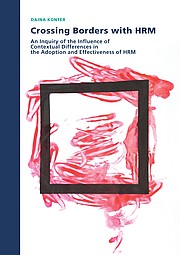Crossing borders with HRM: An inquiry of the influence of contextual differences in the adoption and effectiveness of HRM Defended on Friday, 24 January 2014
The increased global connectivity urges us to look across borders, for previous boundaries may have been broken down or on the contrary have become more visible. In this thesis we explore what it means to cross borders with human resource management (HRM). Many believe in the virtues of the American way of doing business, but does this also mean that the American way of doing business is applicable in other countries? Human resource studies furthermore started in the manufacturing sector, while considerable differences can be expected for other sectors like the service sector. By moving research from Anglo-American countries and the manufacturing sector to a broader context, national and sector borders are crossed. On both the national and the sector level formal institutions have a crucial role in the adoption and effectiveness of HR practices. We have examined whether organizations across different institutional contexts embrace different ways of managing human resources and whether different results can be achieved. Even though our research provides support for the relevance of a fit of HRM with its context, the importance of best practices can not be discarded. Both aspects are important to consider in future research when studying HRM and performance in a globalizing world. By providing useful insights for practitioners this research can finally also crossover from academia back to practice.
Keywords
human resource management; institutional context; performance; best practice and best fit; international comparative research













